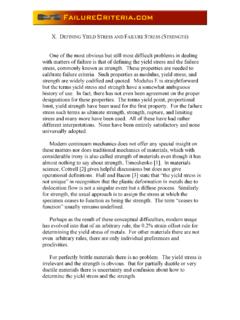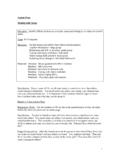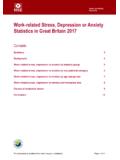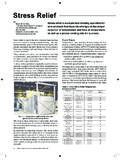Transcription of STRESS - Roderic Gray
1 Practitioner papers WORKPLACE STRESS a review of the literature Roderic Gray 1998 | 1 Workplace STRESS has been identified as a serious cause of individual suffering and commercial loss. This review examines published evidence on the causes and effects of STRESS , and the implications for managers in organisations. The nature of STRESS STRESS is "a reality like love or electricity - unmistakable in experience but hard to define (Teasdale and McKeown, 1994). Occupational STRESS has been designated one of the top ten industrial diseases in the US (British Psychological Society, 1988).
2 Willcox (1994), comments that previous research supports the view that at least 25% of the working population is psychologically stressed at any one time. If this is true it has serious implications for the health of society as a whole, a point acknowledged in the government document The Health of The Nation (HMSO, 1992) when it identifies mental health as one of the key areas needing to be addressed to enhance the nation s health. The study of STRESS begins with a difficulty of definition. Williams (1994) describes STRESS as one of the most inaccurate words in the scientific literature because it is used to describe both the sources and the effects of the STRESS process.
3 MacLean (1985) remarks that the word is sometimes used to denote stressful events, sometimes to denote the effect of these events on work performance, and sometimes to denote an individual s reaction in terms of disordered health. This confusion permeates much of the literature. Not only is there disagreement about the meaning of the term, there is disagreement about how it should be measured and there is a lack of understanding about quite how aspects of the environment might actually make a person ill (Marmot and Madge, 1987). These issues about the fundamental nature of STRESS preoccupied many researchers during the seventies and eighties as they tried to determine whether STRESS was a characteristic of the environment, an experience felt by the person, or a transactional phenomenon created by the process of the person interacting with the environment (Schuler and Jackson, 1986).
4 Lazarus (1971) had earlier observed that STRESS referred to such a broad class of problems: any demands which tax the system, whatever it is, a physiological system, a social system or a psychological system, and the response of that system. This was clearly a wide field for enquiry, to the extent that many researchers in the field concluded that the concept of STRESS is no longer useful as a scientific construct (Schuler and Jackson, 1986). Ten years later the term is still very much in use and there is greater consensus about its meaning. If there has been difficulty in determining what STRESS is, then how to measure it has been even more problematical.
5 According to Kasl (1987): It has been impossible to identify and agree upon a criterion, or more appropriately a set of criteria, for identifying the presence of a state of STRESS and then calibrating its intensity and duration. Cox (1993) draws attention to the importance for general health of a state of balance between needs and demands, citing the World Health Organisation s definition of well-being: a dynamic state of mind characterized by reasonable harmony between a person s abilities, needs and expectations, and environmental demands and opportunities (WHO, 1986).
6 Assessing this dynamic state of mind however, presents great methodological difficulties, leading Cox (1993) to comment that sadly, much of what is currently published on occupational STRESS and health is weak methodologically, the available evidence being based to some extent on cross-sectional studies where key variables are measured and linked only in terms of self-report (Kasl, 1992). Levi (1992), however, is adamant that the individual s subjective assessment is the only valid measure of well-being available. Similarly, Lazarus and Folkman (1984 ) argue that given the centrality of internal events and processes.
7 We are in favour of this method despite its scientific defects. Cox and Griffiths (1995) appear to apply this belief specifically to STRESS research when they argue that the measurement of the STRESS state should be based primarily on self-report measures which focus on the appraisal process and on the emotional experience of STRESS . Instruments for collecting such self-report data in a systematic and rigorous way have been developed. One such widely-used and validated instrument (Robertson, Cooper and Williams, | 2 1990; Cooper and Williams, 1991; Rees and Cooper, 1991) is Cooper s Occupational STRESS Indicator [OSI], developed in the late 1980s.
8 The OSI asks a total of 167 questions dealing with sources of STRESS , general behaviour, life events, control/influence, coping behaviour and job satisfaction. Computer software is used to analyse the answers to produce a coefficient index (see Willcox, 1994). The study of occupational STRESS Hans Selye is regarded by many as the father of STRESS research. His book The STRESS Of Life (1956) did much to bring the concept into the public domain and his General Adaptation Syndrome [GAS] is one of the seminal concepts in the field. Selye (1974) described STRESS as a state, manifested by a specific syndrome of biological events.
9 He argued that it was not nervous tension, nor the discharge of hormones from the adrenal glands, nor simply the influence of some negative occurrence. He also maintained that it was not an entirely bad event. What STRESS is, according to Selye, is the nonspecific response of the body to any demand on it for readjustment or adaptation. Any kind of normal activity .. can produce considerable STRESS without causing any harmful effects (Selye, 1974), later clarified as the nonspecific [that is, common] result of any demands upon the body, be the effect mental or somatic (Selye, 1982).
10 Selye s neutral application of the term is not adopted by French, Caplan and van Harrison (1982), the authors of a major enquiry into the mechanisms of STRESS in the workplace. They use STRESS only in negative contexts, to refer to any of the following technical concepts: [1] objective misfit; [2] subjective misfit; [3] a variable in the objective environment which is presumed to pose a threat to the person; and [4] a variable in the subjective environment which the person perceives as threatening. Schuler and Jackson (1986) argue that STRESS is a function of uncertainty, a perceived dynamic state involving uncertainty about something important.







